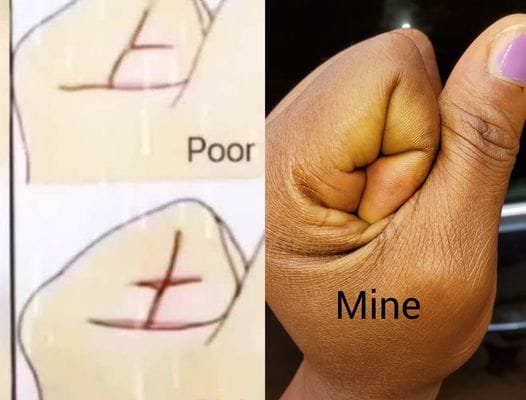Understanding Wealth Lines in Palmistry
In the realm of palmistry, certain markings on the hands are believed to signify financial prosperity or challenges. For example, crossed lines near the base of the thumb are traditionally seen as indicators of financial difficulties. On the other hand, deep, well-defined crosses on other areas of the palm are thought to signify wealth, success, and stability. According to palmistry enthusiasts, these markings may offer hints about a person’s financial future, revealing whether they are destined for riches or struggles.
Illustrations of these interpretations often label palms with faint or unclear lines as “Poor,” suggesting limited financial potential, while palms with bold, clear lines are marked as “Rich,” symbolizing a higher likelihood of financial success. This humorous comparison implies that one’s financial fate could be “written” in their hands—a concept rooted in the folklore of many cultures.
The Cultural Significance of Palmistry
Throughout history, palmistry has held a special place in various cultures around the world. Different belief systems claim that specific line patterns, like crosses or unique intersections, can reflect a person’s fate, character, or financial potential. In traditional folklore, palm readings are often used to gain insights into one’s personal life, including relationships, career prospects, and financial outlook.
However, the interpretations of palm lines can vary significantly across different cultures and belief systems. In some traditions, a particular line might symbolize good fortune and prosperity, while in another, the same line could indicate challenges or struggles. This diversity of interpretations adds a rich layer of cultural nuance to the practice of palmistry, showcasing how unique perspectives have influenced its meanings over the centuries.
Despite the varying interpretations, the idea that one’s hands hold secrets about their future remains a common thread. Palmistry has been passed down through generations, with many families continuing the tradition as a way to connect with their heritage and explore age-old beliefs about destiny.
Modern Perspectives on Palmistry: Science vs. Belief
In the modern world, palmistry is often met with skepticism. From a scientific standpoint, it is generally viewed as a pseudoscience, as there is no empirical evidence to support the claim that the lines on a person’s hand can predict their future or financial status. Scientists argue that these lines are simply natural folds in the skin, influenced by genetics and environmental factors, rather than indicators of fate.
Nevertheless, the practice of palmistry has not lost its allure. For many, it’s a fun and engaging activity, similar to reading horoscopes. People often approach palmistry with a light-hearted attitude, seeing it more as a form of entertainment than a serious method of predicting the future. While some believe in the insights palmistry offers, others simply enjoy the experience as a playful exploration of personality traits.
Even among skeptics, palmistry can still serve as a tool for self-reflection. Like astrology, it can provide a framework for people to think about their lives, goals, and challenges. In this sense, palmistry becomes less about predicting actual events and more about exploring the symbolic meanings behind the lines on our hands.
Why Palmistry Continues to Fascinate
Despite the skepticism surrounding palmistry, its enduring popularity speaks to a deeper human curiosity about the future. The idea that the lines on our hands could reveal hidden truths about our lives is both intriguing and comforting. It allows people to feel a sense of control, even if just symbolically, over their destiny.
Palmistry remains a common feature at fairs, festivals, and even among friends at social gatherings. It’s a way for people to bond over shared curiosity, engaging in conversations about what the lines on their palms might signify. Whether you take it seriously or not, there’s something undeniably fascinating about the idea that your hands could hold secrets about your personality, relationships, or financial future.
Even today, many people still visit palm readers, not necessarily to find definitive answers, but to enjoy the experience of exploring what their hands might reveal. For those who are intrigued, palmistry offers a mix of tradition, mystery, and a touch of fun.
Conclusion: Palmistry as an Enduring Tradition
In conclusion, while palmistry may lack scientific backing, it remains a captivating tradition that has stood the test of time. It provides a fascinating way to explore ancient beliefs about fate, personality, and financial potential. For some, it’s a serious practice, while for others, it’s simply a fun and light-hearted pastime.
Whether you’re interested in palmistry for its cultural history or just curious about what your hands might say about you, the practice continues to endure. It’s a reminder that humans have always been drawn to the idea of uncovering hidden secrets about their lives, whether through science, art, or ancient traditions. So, the next time someone offers to read your palm, why not indulge in a little curiosity? You might just discover something interesting—whether you believe in it or not.



